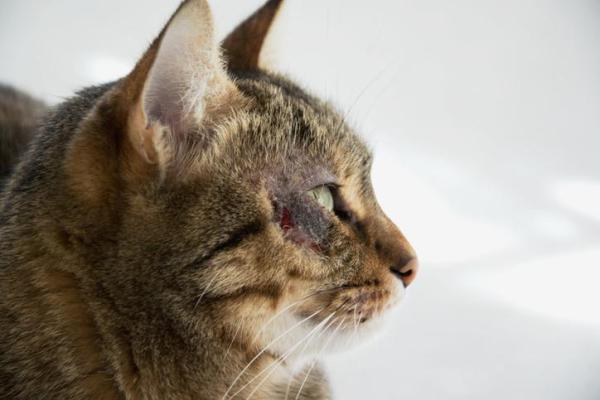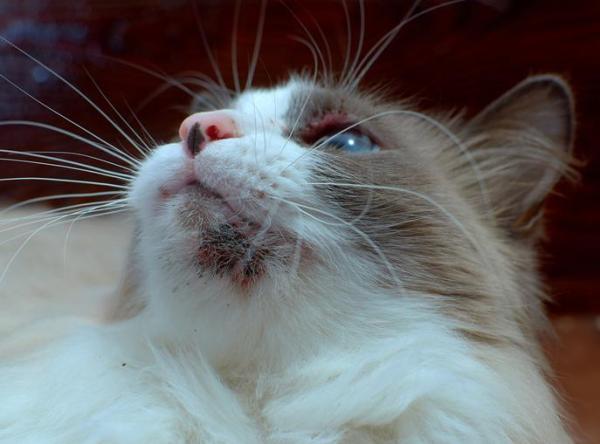
For many cats, it is normal to have a thinner patch of hair in the area between their eyes and the base of their ears. As with humans, it is also common for parts of their coat to become thinner as they age. Unlike humans, most cats have hair all over their body. Despite this fact, the area above the eyes often seems to lose hair more than other areas. Although age can be a factor, there are also important health reasons why your cat has bald spots over the eyes. Some of them can be localized to this area, while others are due to systemic problems. Find out the different reasons for alopecia above the eyes in cats with AnimalWised.
Is it normal for a cat to have bald spots over their eyes?
As with many physical traits and characteristics of cats, the amount of hair they have on their head will vary. This will be according to many factors, including breed, age, health status and many others. Not all the reasons for their appearance are necessarily categorizable, as some will simply have a certain look which doesn't imply anything is wrong.
For many cats, a slight thinning above the eyes is normal. This is especially the case with black cats or those with darker hair in this area. The reason is because the contrast between the dark hair and the light skin underneath is more stark. When the light shines on it in a certain way, we can see the light skin more easily due to the contrast with the dark hair. This contrast is not as visible in lighter-haired cats.
The time of year is also a factor. In the spring, a cat will go through a shedding season when their thick winter coat will start to molt. For this reason, the patch of fur above their eyes may be noticeably a little thinner. It will then become less noticeable once the winter coat grows back in.
In this context, we need to differentiate between these patches of naturally thinner hair and when abnormal alopecia (hair loss in cats) occurs.
Parasites
External parasites may be the reason why your cat is developing bald spots above their eyes. When an external parasite such as a flea or mite embeds on the skin of a cat, they start to bite. This biting or other irritation causes the cat to feel itchy. They will then repeatedly scratch this area and can cause their hair to fall out in patches.
Not all parasites are the same. Larger parasites such as lice and ticks may be seen by the naked eye. Others are so small, they can be very difficult to detect. We only see this when they start to scratch themselves raw in the area the parasites are located or if we see the cat's hair start to fall out. For this reason, it is important to go to a veterinarian to confirm the cat has parasites and determine their type.
Treatment of feline parasitosis
The treatment of a parasite infestation (parasitosis) will consist of the use of antiparasitic products such as pipettes or sprays. These will be used to deworm the cat and help prevent further parasitosis. The cat's living area may need to be cleaned to ensure there are no remaining parasites in their environment. We will need to deworm them regularly to best ensure the parasites and any subsequent hair loss will not return.

Contact or atopic dermatitis
Dermatitis is a general term for inflammation of the skin and is applicable to any area of skin on the cat's body. For this reason, there are many types which are dependent on the underlying cause. In many cases, the dermatitis is a secondary symptom of another issue.
A common example of types of dermatitis in cats is contact dermatitis as a response to allergies. When the cat's skin comes in contact with an allergen to which they have a sensitivity, the skin will become inflamed, red and itchy. In severe cases, it can even become painful and purulent. Cats can have sensitivities to almost anything, but flea bites, cleaning products and dust are just some common examples.
Atopic dermatitis is a type of feline dermatitis which does not have a known cause. It is thought to be related to genetics and a lowered immune system. When the immune system is lowered, it cannot fight against the inflammation and the dermatitis can flare up. In addition to to the swelling and redness, we may see the cat has scabs on their skin or even flesh blood due to scratching.
Treatment of dermatitis in cats
Treatment will depend on the severity of the case and its underlying cause. In allergic processes, the allergen will need to be removed from the cat's environment. They may need antihistamine treatment when the allergic response is very bad. For immune-mediated conditions, the problem may not be cured, but we can use symptom management to improve their quality of life. This may include bolstering their immune system and using topical creams.

Ringworm (dermatophytosis)
One of the most common causes that cause a cat to have bald spots on its head is ringworm, also known as dermatophytosis. While it may sound like another type of parasite, ringworm is actually a fungal infection. In felines, the most common fungus which causes infection is the dermatophyte Microsporum canis. Cats can also be infected by Trichophyton mentagrophytes, Microsporum persicolor, Microsporum gypseum, Microsporum fulvum and Terrestrial Trichophyton.
This is a more common infection in kittens and long-haired cats. These fungi produce lesions on the skin which can cause the hair around it to fall out. This can lead to bald spots above their eye, in which we can see circular alopecic plaques. These commonly affect the upper area of the eyes, ears, face and legs. They also present skin inflammation, peeling and scabs, but itching may not be present in many cases.
Treatment of feline ringworm
Being a contagious infectious disease, the treatment should include thorough home disinfection while treating the cat with oral antifungal treatment, such as itraconazole for cats. Topical creams and shampoos may also be administered and a suitable deworming schedule needs to be implemented.

Aging
All of our cats have hair in the upper area of their eyes that is usually somewhat finer than the rest. This fineness increases with age, appearing from 14 to 20 months of age in the cats most predisposed to it. It is particularly evident in old age, when they may appear to have bald spots above the eyes. As stated above, dark-colored and black cats have more noticeable bald spots due to the contrast with their skin.
If your cat has bald patches above their eyes, they are elderly and they do not present obvious symptoms of any pathology, it is most likely due to the normal signs of aging in cats. In these cases, the only thing you can do is offer your cat the best quality of life and pay close attention to any signs of disease.
Stress
Bald spots in cats due to stress are more common than we may think. Cats are particularly sensitive to stress due to various causes. These include moving home, new family members, changes in routine, loud noises, travel, illness of their caregivers, etc. All these changes can make your cat more nervous than usual. The cat may groom excessively as a way to feel calm, resulting in bald spots and thinning. The accessibility of their head means it often occurs in the area above the eyes and between the ears.
Feline stress treatment
It is important to keep our cats in appropriate conditions. A peaceful home is one of the most important environmental factors. After ensuring their basic needs are covered, we also need to ensure they have the right levels of affection, play engagement and mental stimulation. We can help them relax by using synthetic feline pheromones, but meeting their individual needs is important.

Folliculitis
Folliculitis is the term for inflammation of the hair follicles. It can affect the upper area of the eyes and cause hair loss, as well as itching, skin flaking, lesions and scabbing. In some cases, it can be caused by feline acne when the sebaceous glands associated with the follicles overproduce sebum and increase keratin production.
We most commonly see feline acne with what appears as black dandruff on the cat's mouth and chin, but it can spread to other areas. It can lead to pyoderma, a type of skin infection which causes redness, skin inflammation, swelling and discomfort.
Treatment of feline folliculitis
Treatment in cases of feline acne consists of the use of topical therapy using antimicrobial and antiseptic creams or ointments. These include chlorhexidine and benzoyl peroxide. Maintaining proper hygiene of the areas is also important. When a skin infection has occurred, the cat should also be treated with systemic antibiotics.

Sun dermatosis
Our cats can also suffer the consequences of the sun's ultraviolet rays. This light radiation can cause burns that lead to hair loss, as well as scabs in the affected area. Since the patch above a cat's head may already have thinner hair, this is a common area where sun damage can occur. Other symptoms include redness and swelling. Cats with lighter colored coats are generally more affected.
Sun damage can also lead to other skin problems for cats, including tumors. These can be in the form of melanomas which can metastasize to other areas of the body. Although we may think our cat has skin protection due to their hair, it is important to best ensure they are protected in sunny weather. This is especially the case as cats enjoy bathing in the sun for prolonged periods.
Treatment of feline solar dermatosis
The best way to prevent solar dermatosis in cats is to prevent them from sunbathing during the most critical hours of the day. Especially in the summer months, the increase in UV rays pose a serious health risk. The use of sunscreens for cats is recommended, especially in cats with outdoor access. In the event that your cat has already been burned, you should take care of the area by using moisturizing and soothing products.
As you have seen, if your cat has bald spots above their eyes, it is best to go to a veterinary center. There are many causes of alopecia on the head of a cat, some more benign than others. Diagnosis from a professional will best ensure we can maintain their health and well-being.

This article is purely informative. AnimalWised does not have the authority to prescribe any veterinary treatment or create a diagnosis. We invite you to take your pet to the veterinarian if they are suffering from any condition or pain.
If you want to read similar articles to My Cat Has Bald Spots Above Their Eyes, we recommend you visit our Skin problems category.
- Harvey, R. G., & McKeever, P. J.. (2001). Illustrated manual of skin diseases in dogs and cats. Grass editions.